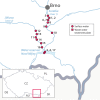Detection of Plasmid-Mediated Resistance to Metronidazole in Clostridioides difficile from River Water
- PMID: 35950844
- PMCID: PMC9431275
- DOI: 10.1128/spectrum.00806-22
Detection of Plasmid-Mediated Resistance to Metronidazole in Clostridioides difficile from River Water
Abstract
Clostridioides difficile is one of the most important human pathogens. The identification of its possible sources is important for the understanding of C. difficile infection (CDI) epidemiology. A total of 16 water samples from wastewater and surface water in South Moravia in the Czech Republic and 82 samples of fish and gulls were collected between May and July 2019. C. difficile isolates were cultured by direct plating and after enrichment on chromogenic media. Susceptibility testing to eight antimicrobials was performed by Etest. C. difficile isolates were characterized by ribotyping, multilocus sequence typing, multilocus tandem repeats analysis, and toxin gene detection. Samples from fish and gulls were C. difficile negative; a total of 15 C. difficile isolates from 8 out of 16 water samples were cultured (6 out of 14 surface water samples yielded 6 isolates, and 2 out of 2 wastewater samples yielded 9 isolates). Direct plating was culture positive in 6 out of 16 samples (12 isolates), and enrichment culture was positive in an additional 2 out of 16 samples (3 isolates). Twelve different ribotyping profiles and 14 sequence types of clades 1, 4, and 5 were identified. Five isolates did not carry genes for toxins, and eight isolates carried genes for toxins A and B; the remaining two isolates (RT078) carried the genes for toxins A, B, and binary. All C. difficile isolates were susceptible to amoxicillin, moxifloxacin, tetracycline, and vancomycin and resistant to ciprofloxacin. A high level of erythromycin resistance (>256 mg/L) was detected in eight isolates. Clindamycin resistance was found in 14 isolates, 6 of which showed a high level of resistance (>256 mg/L) and carried ermB. Surprisingly, one isolate (RT010, ST15) showed resistance to metronidazole (12 mg/L) with the presence of the plasmid pCD-METRO. In conclusion, a diverse spectrum of C. difficile strains was found in wastewater and surface water. A recently discovered plasmid-bound resistance to metronidazole was detected in C. difficile from the surface water sample. IMPORTANCE The combination of direct plating and culture after enrichment was used in order to gain a spectrum of C. difficile ribotypes present in the water samples. Toxigenic C. difficile ribotypes detected in surface water and in wastewater treatment plants overlapped with those derived from patients with CDI and/or animals. Importantly, a recently discovered plasmid-mediated resistance to metronidazole, a drug used for the treatment of CDI, was detected in C. difficile from river water.
Keywords: MLST; antimicrobial resistance; erm(B); plasmid-bound metronidazole resistance; ribotyping; surface water; wastewater treatment plant.
Conflict of interest statement
The authors declare no conflict of interest.
Figures


Similar articles
-
Dogs as carriers of virulent and resistant genotypes of Clostridioides difficile.Zoonoses Public Health. 2022 Sep;69(6):673-681. doi: 10.1111/zph.12956. Epub 2022 May 12. Zoonoses Public Health. 2022. PMID: 35546073 Free PMC article.
-
Molecular epidemiology and antimicrobial resistance patterns of Clostridioides difficile isolates in Algerian hospitals.J Infect Dev Ctries. 2022 Jun 30;16(6):1055-1063. doi: 10.3855/jidc.16056. J Infect Dev Ctries. 2022. PMID: 35797301
-
Sequence-Based Identification of Metronidazole-Resistant Clostridioides difficile Isolates.Emerg Infect Dis. 2022 Nov;28(11):2308-2311. doi: 10.3201/eid2811.220615. Emerg Infect Dis. 2022. PMID: 36286226 Free PMC article.
-
A narrative review of Clostridioides difficile infection in China.Anaerobe. 2022 Apr;74:102540. doi: 10.1016/j.anaerobe.2022.102540. Epub 2022 Feb 24. Anaerobe. 2022. PMID: 35219837 Review.
-
Antimicrobial resistance in Clostridioides (Clostridium) difficile derived from humans: a systematic review and meta-analysis.Antimicrob Resist Infect Control. 2020 Sep 25;9(1):158. doi: 10.1186/s13756-020-00815-5. Antimicrob Resist Infect Control. 2020. PMID: 32977835 Free PMC article.
Cited by
-
Newly emerging metronidazole-resistant Clostridioides difficile PCR ribotype 955 identified in Poland, 2021 to 2023 but not in Czechia, 2012 to 2023 and Slovakia, 2015 to 2023.Euro Surveill. 2025 May;30(21):2400675. doi: 10.2807/1560-7917.ES.2025.30.21.2400675. Euro Surveill. 2025. PMID: 40444372 Free PMC article.
-
Genetic determinants of resistance to antimicrobial therapeutics are rare in publicly available Clostridioides difficile genome sequences.J Antimicrob Chemother. 2024 Jun 3;79(6):1320-1328. doi: 10.1093/jac/dkae101. J Antimicrob Chemother. 2024. PMID: 38598696 Free PMC article.
-
Abundant geographical divergence of Clostridioides difficile infection in China: a prospective multicenter cross-sectional study.BMC Infect Dis. 2025 Feb 7;25(1):185. doi: 10.1186/s12879-025-10552-y. BMC Infect Dis. 2025. PMID: 39920584 Free PMC article.
-
Spore-Forming Clostridium (Clostridioides) difficile in Wastewater Treatment Plants in Western Australia.Microbiol Spectr. 2023 Feb 14;11(1):e0358222. doi: 10.1128/spectrum.03582-22. Epub 2022 Dec 8. Microbiol Spectr. 2023. PMID: 36475924 Free PMC article.
-
Non-human Clostridioides difficile Reservoirs and Sources: Animals, Food, Environment.Adv Exp Med Biol. 2024;1435:329-350. doi: 10.1007/978-3-031-42108-2_15. Adv Exp Med Biol. 2024. PMID: 38175482
References
Publication types
MeSH terms
Substances
LinkOut - more resources
Full Text Sources

